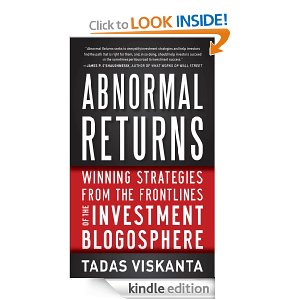When two amateurs play tennis, the one that makes the least amount of mistakes usually wins. The same rule often applies to investing except that what matters more is not the number of mistakes, but their size. While Tadas Vishkanta doesn’t necessarily teach his readers what to do in his first book – Abnormal Returns; he does an even more important job by highlighting what not to do.
Tadas looks at investing from all perspectives imaginable and paints a rich portrait of the market reality, without saving the uncomfortable truth. While Abnormal Returns reads like a textbook at times, it provides deep market understanding of the common hurdles each market participant faces in this enormously challenging field. Unbiased, with no issue that could blind his objectiveness, Vishkanta summarizes and explains a ton of practical investment wisdom from some of the best financial minds of our time.
Abnormal Returns is really informative reading that will enrich your understanding of financial markets. Certainly a worthwhile addition to your investing library.
Here are ten insights I was reminded of by reading the book:
1. Opportunity cost is often overlooked, not only in terms of return, but also in terms of time:
The time and effort spent in trying to become an accomplished trader, by definition, come at the expense of other activities. The biggest cost to the 90% or so of traders who fail is not necessarily the financial costs, but rather the time lost to other opportunities. Money can be made in a number ways, trading only being one of them. However, time is not something any of us can get back.
2. Know your limits:
Great investors recognize that once they make an investment decision, the results are largely out of their control. They can have a plan about when to sell, but the market will ultimately dictate how that investment works out over time.
3. The worst forecasters are often the most confident. Once in a while, they hit the jackpot like a blind squirrel finds an acorn sometimes.
Analysts who correctly called the market crash of 1987 have been living off that call ever since then. The irony is that research shows that those forecasters who get these “big calls” correct turn out to have the worst overall track records.
4. Finding skilled money managers is one of the hardest endeavors on earth
First, we should recognize that investing is a field in which both skill and luck do play a role. Investing is often compared to gambling and most often to poker, and for good reason. Recent research also shows, contrary to what the authorities say, that poker on the whole is a game of skill. Unfortunately for investors, our ability to identify skilled investment managers is much more difficult than identifying skilled poker players.
5. Distinguish between skill and chance
Fama and French examine the performance of mutual fund managers and find that before expenses the top 5% or so of managers demonstrate some skill compared with chance.9 The performance picture worsens dramatically once you take into account expenses, which largely wipe out the benefit of skill in the best managers. You can guess what it does for the rest of the mutual fund manager crowd. Anyone looking for skilled managers needs to recognize that identifying skill isn’t enough. The challenge is identifying managers whose skill outweighs whatever fees they charge investors.
6. Different catalysts rule the market in the short-term vs the long-term
Howard Marks says it well: “In the long run, there’s no reasonable alternative to believing that good decisions will lead to investment profits. In the short run, however, we must be stoic when they don’t.” We live in a world filled with randomness, and recognizing this is an important step in dealing with our investments in a more measured and mature fashion.
7. Confirmation bias hurts us more than we could imagine. “On a subconscious level, we simply never perceive information that may not fit with our worldview.”
8. “You may think you’re able to filter the noise. You cannot; it overwhelms you. So don’t fight the noise—block it.”
9. Momentum investing works because it is psychologically hard to apply
Momentum works because it calls on investors to do things that do not come naturally. Momentum strategies require investors to buy things that have already increased in value and are trading near their highs, not their lows. Successful momentum strategies also have strict and well-defined selling, or switching, strategies. Both these pieces of the momentum puzzle are difficult for investors to master.
10. Value investing works because it is also psychologically uncomfortable to practice:
This is a more challenging task than simply buying stocks that are statistically cheap. Swensen writes, “In many instances, value investing proves fundamentally uncomfortable, as the most attractive opportunities frequently lurk in unattractive or even frightening areas.”
Howard Marks writes: “To boil it all down to just one sentence, I’d say the necessary condition for the existence of bargains is that perception has to be considerably worse than reality. That means the best opportunities are usually found among things most others won’t do.”
Source: Viskanta, Tadas (2012-03-30). Abnormal Returns: Winning Strategies from the Frontlines of the Investment Blogosphere, McGraw-Hill. Kindle Edition.
